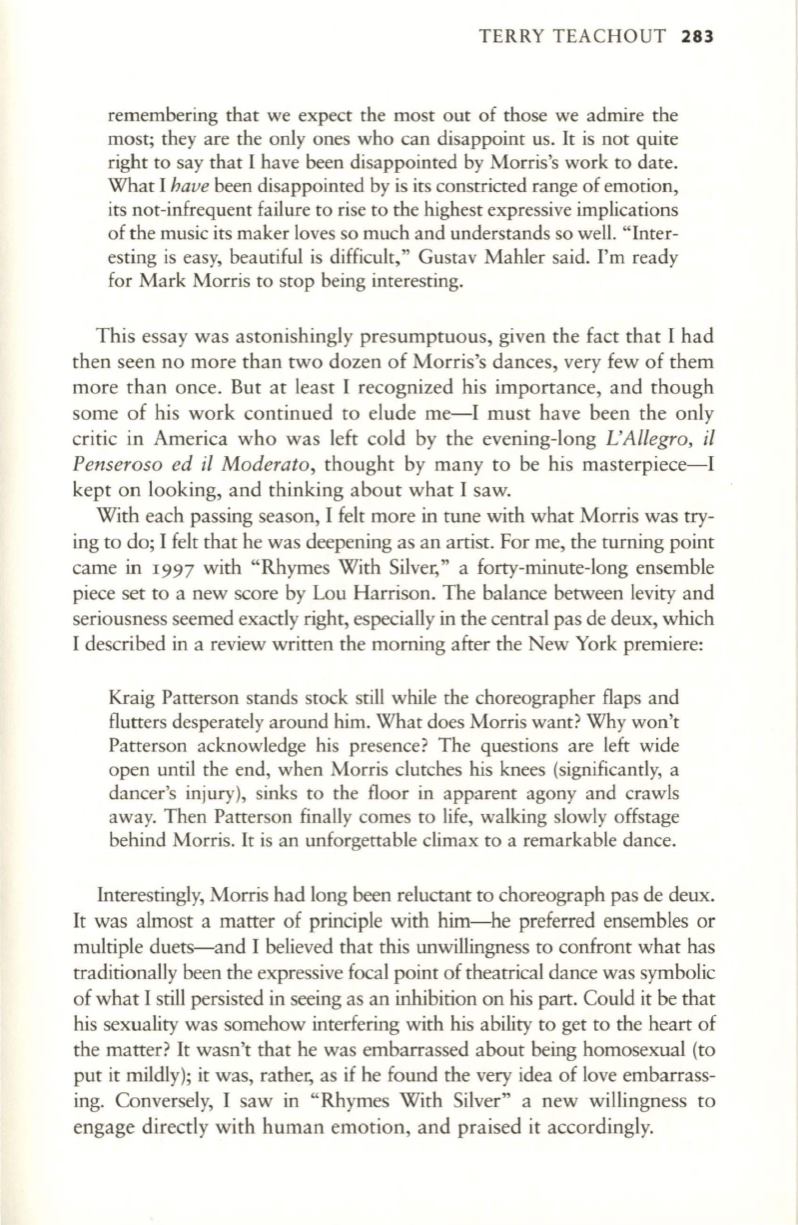
TERRY TEACHOUT
283
remembering that we expect the most out of those we admire the
most; they are the only ones who can disappoint us. It is not quite
right to say that I have been disappointed by Morris's work to date.
What I
have
been disappointed by is its constricted range of emotion,
its not-infrequent failure to rise to the highest expressive implications
of the music its maker loves so much and understands so well. "Inter–
esting is easy, beautiful is difficult," Gustav Mahler said. I'm ready
for Mark Morris to stop being interesting.
This essay was astonishingly presumptuous, given the fact that I had
then seen no more than two dozen of Morris's dances, very few of them
more than once. But at least I recognized his importance, and though
some of his work continued to elude me-I must have been the only
critic in America who was left cold by the evening-long
L'Allegro, il
Penseroso ed il Moderato,
thought by many to be his masterpiece-I
kept on looking, and thinking about what I saw.
With each passing season, I felt more in tune with what Morris was try–
ing to do; I felt that he was deepening as an artist. For me, the turning point
came in
1997
with "Rhymes With Silver," a forty-minute-long ensemble
piece set to a new score by Lou Harrison. The balance between levity and
seriousness seemed exactly right, especially
in
the central pas de deux, which
I described in a review written the morning after the New York premiere:
Kraig Patterson stands stock still while the choreographer flaps and
flutters desperately around him. What does Morris want? Why won't
Patterson acknowledge his presence? The questions are left wide
open until the end, when Morris clutches his knees (significantly, a
dancer's injury), sinks to the floor in apparent agony and crawls
away. Then Patterson finally comes to life, walking slowly offstage
behind Morris.
It
is an unforgettable climax to a remarkable dance.
Interestingly, Morris had long been reluctant to choreograph pas de deux.
It was almost a matter of principle with him-he preferred ensembles or
multiple duets-and I believed that this unwillingness to confront what has
traditionally been the expressive focal point of theatrical dance was symbolic
of what I still persisted in seeing as an inhibition on his part. Could it be that
his sexuality was somehow interfering with his ability to get to the heart of
the matter?
It
wasn't that he was embarrassed about being homosexual (to
put it mildly); it was, rather, as
if
he found the very idea of love embarrass–
ing. Conversely, I saw in "Rhymes With Silver" a new willingness to
engage directly with human emotion, and praised it accordingly.


